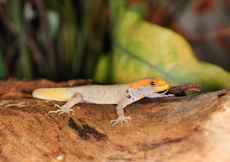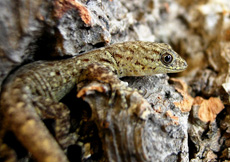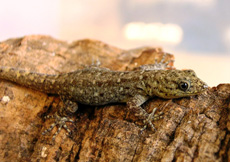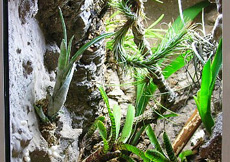Gonatodes albogularis notatus
(REINHARDT & LÜTKEN, 1862)
Distribution:
Jamaica and Hispaniola
Description:
Gonatodes albogularis notatus is the smallest subspecies of Gonatodes albogularis albogularis. Males reach an overall length of 7.5 centimeters, while females remain slightly smaller at around 7 centimeters. In this subspecies, the sexual dimorphism is very pronounced. The back of males is gray. Their head is yellow and the throat has an orange colored pattern. On the left and right side between the head and body are bluish stripes, behind these, a barely visible eye-spot can be seen. The lips are yellow, with bluish stripes. The tail is also yellow. In front of the hind legs is a black stripe. Ventrally, the males of Gonatodes albogularis notatus are light gray, while the underside of the tail is light brown.
The base color of the female is light brown, which is carried on to the tail, at the legs this fades to yellow. The body is covered with bright and dark speckles. On the back a bright band extends centrally from head to tail, flanked by two rows of dark spots. Ventrally, they are light gray, with a yellowish throat. The underside of the tail is lightly colored and patternless.
The young animals show the same coloration as the females, only in slightly darker shades.
Habitat:
Little information is known about their natural habitat. In my experience however, it has shown to be very similar to the nominant form.
Husbandry and Breeding:
A pair may be kept problem free in a terrarium measuring 30x40x30 centimeters. Pieces of cork or bark should be affixed to the rear and side walls, to offer the geckos climbing surfaces. The preferred substrate is a mixture of sand and soil, to a depth of 4 centimeters. The addition of cork tubes and branches provides the geckos with additional climbing surfaces. The vegetation can be a mixture of ground covers and small plants, however you should make sure the geckos have some free space available to them. A small bowl of water and a bowl of crushed up cuttlefish bone complete the decor.
The terrarium can be illuminated with one or two T5 fluorescent lamps, rated for daylight color. Additional heating via heat lamps is not needed or utilized by the animals. Depending on the season, the temperatures will range between 23-30°C (73-86°F).
The animals remain very well hidden, usually between the roots of plants or in cork tubes and leave only to feed. They will eat everything that fits in their mouth, for example small crickets, firebrats, Drosophila, field sweepings and so on.
The females lay only a single egg, which is always buried, the egg measures 4 millimeters. Using an incubation temperature of 28°C (82°F) will ensure the animals hatch between 90-100 days. The young animals are a little over 2 centimeters in size upon hatching.
The young geckos should be offered small prey in the form of springtails or micro crickets, for example. In my experience the juvenile animals grow very slowly. At around 8 months of age, their final coloring begins to show. Gonatodes albogularis notatus are sexually mature and begin to produce eggs at around 1 year.



